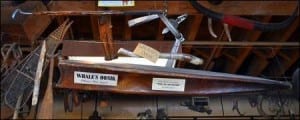Specimen of the Week: One Year Anniversary!
By Emma-Louise Nicholls, on 8 October 2012
 There was a variety of pun-tastic ideas and directions of literary genius that I could have gone in with this first anniversary blog. Closest to the word anniversary is Anniceris which is a type of grasshopper. Pretty cool, but not extraordinary. There is of course the ANNUALaria, which is a genus of mollusc. But we don’t have one. So that’s rubbish. I could have been etymological- the word annual comes from the Latin Annus meaning yearly, but I feel that is uncomfortably close to the word anus, of which we had enough references last week. A change in direction led me to search for species that included the word blog, and subsequently learnt of the existence of Blogiascopora. However it was a biological fail for the search engine as Blogiascopora is a fungus which therefore couldn’t be used for the blog as a) we are a museum of ZOOlogy and b) we (subsequently) don’t have one. So giving up on this idea I decided to choose simply the most elegant, sophisticate, admired and respected specimen in the Museum. This Week’s Specimen of the Week is…
There was a variety of pun-tastic ideas and directions of literary genius that I could have gone in with this first anniversary blog. Closest to the word anniversary is Anniceris which is a type of grasshopper. Pretty cool, but not extraordinary. There is of course the ANNUALaria, which is a genus of mollusc. But we don’t have one. So that’s rubbish. I could have been etymological- the word annual comes from the Latin Annus meaning yearly, but I feel that is uncomfortably close to the word anus, of which we had enough references last week. A change in direction led me to search for species that included the word blog, and subsequently learnt of the existence of Blogiascopora. However it was a biological fail for the search engine as Blogiascopora is a fungus which therefore couldn’t be used for the blog as a) we are a museum of ZOOlogy and b) we (subsequently) don’t have one. So giving up on this idea I decided to choose simply the most elegant, sophisticate, admired and respected specimen in the Museum. This Week’s Specimen of the Week is…
**The Walrus Penis Bone**
1) An impressive 66 cm in length, the walrus penis bone, also known as a baculum, is the second most sought after specimen for adoption, after the more prominently displayed and widely acclaimed (Google it) jar of moles. Many mammal species have penis bones, but humans, there’s no need to look boys, are one of the exceptions. However, primates as closely related to humans as chimps still have them.
2) The true purpose of the penis bone is stiffly debated. Generally, it is agreed that the baculum enables a male to mate for longer, which could be considered an advantage for males of species with certain mating strategies. One slightly obscure theory as to why humans lost their penis bone suggests that as social cultures developed, they allowed for copulation to occur more frequently. As the bone acts as a natural viagra to keep everything up for longer, shorter sex sessions apparently meant that the bone was no longer required. This assumption does not appear to take into account the variables of regularity associated with before and after marriage however.
3) Native Alaskans call the walrus baculum an ‘oosik’ and for them it is almost as valuable a commodity as for the walrus. Alaskans use the penis bones of walruses and other vertebrate mammals to craft knife handles and good luck charms. They are apparently sold as often to locals as to tourists, proving them to be more than just a gimmick.
4) Walruses are highly gregarious though spend little time with members of the opposite sex. They can be seen lounging about on the ice in great numbers, packed so tightly together in their mostly single sex colonies, that they frequently pile on top of one another.
5) For some reason, walruses choose the middle of the harsh cold Arctic winter to mate. No wonder the males need a little added structural support. From January to April females lie on ice floes as males jostle for aquatic real estate nearby. The walruses of days gone by sorted their culture with the uttermost wisdom and subsequently, it is down to the females to choose the best looking man, with whom she will mate. Normally in the water. The ladies however do not mind if (or more to the point ‘when’) the most dominant males mate with several other females as well as her. They are apparently looking to have the cutest pups, not a life long monogamous romantic association. Females mature sexually around the age of seven and typically give birth for the first time around nine. Males on the other hand don’t become sexually mature until between seven and ten years. However, due to their ‘socially immaturity’ (love that phrase) they do not tend to mate until around the age of 15.
If you feel the need for a further poke about in the world of penises, it just so happens there is a super blog by another UCL researcher, investigating the size of said members: Does size matter? Evolution and the primate penis.
Emma-Louise Nicholls is the Museum Assistant at the Grant Museum of Zoology
2 Responses to “Specimen of the Week: One Year Anniversary!”
- 1
 Close
Close





Well! You learn something new everyday! Next time I’m stuck for a topic of conversation at a party, I shall remember this blog!